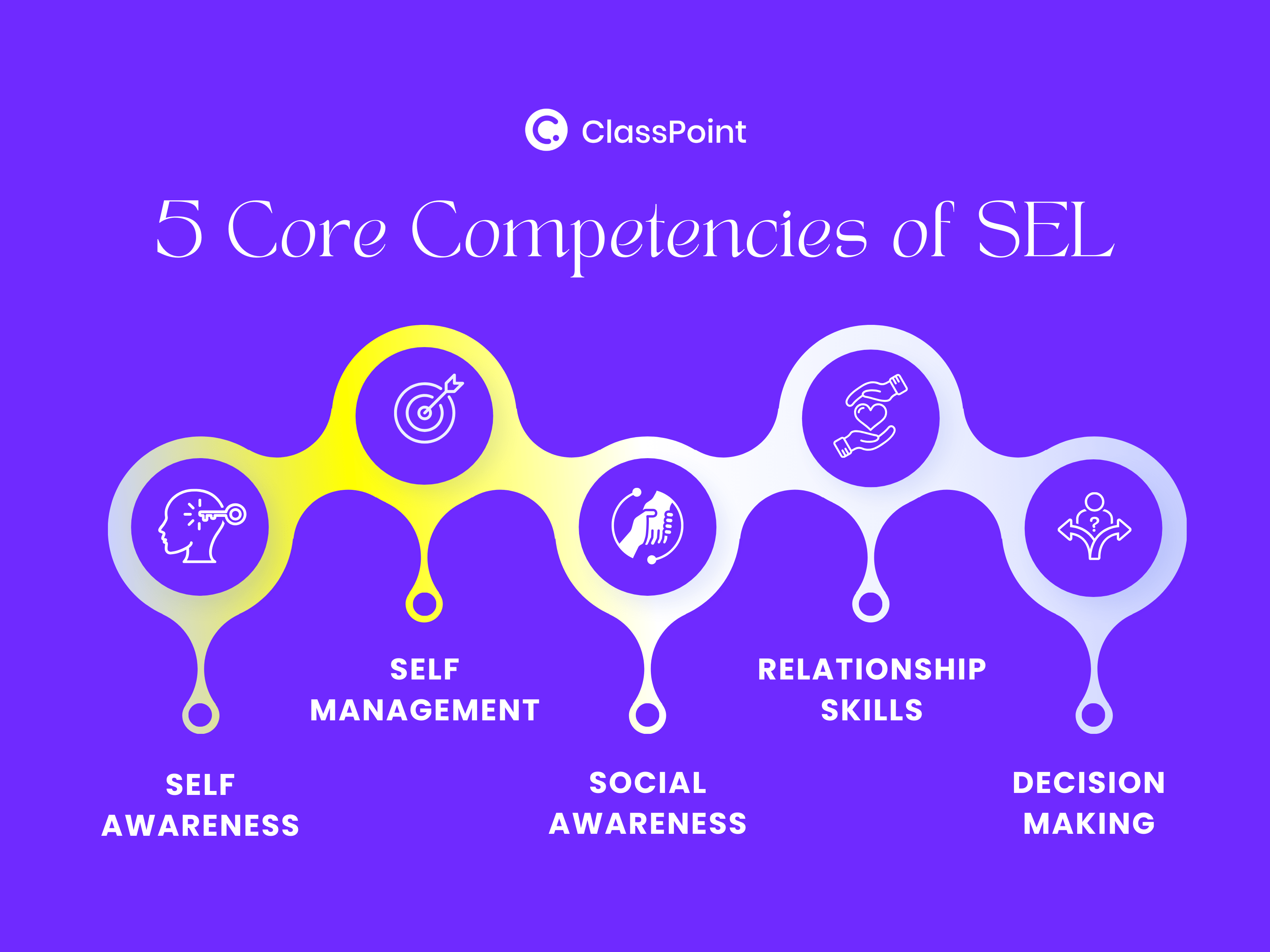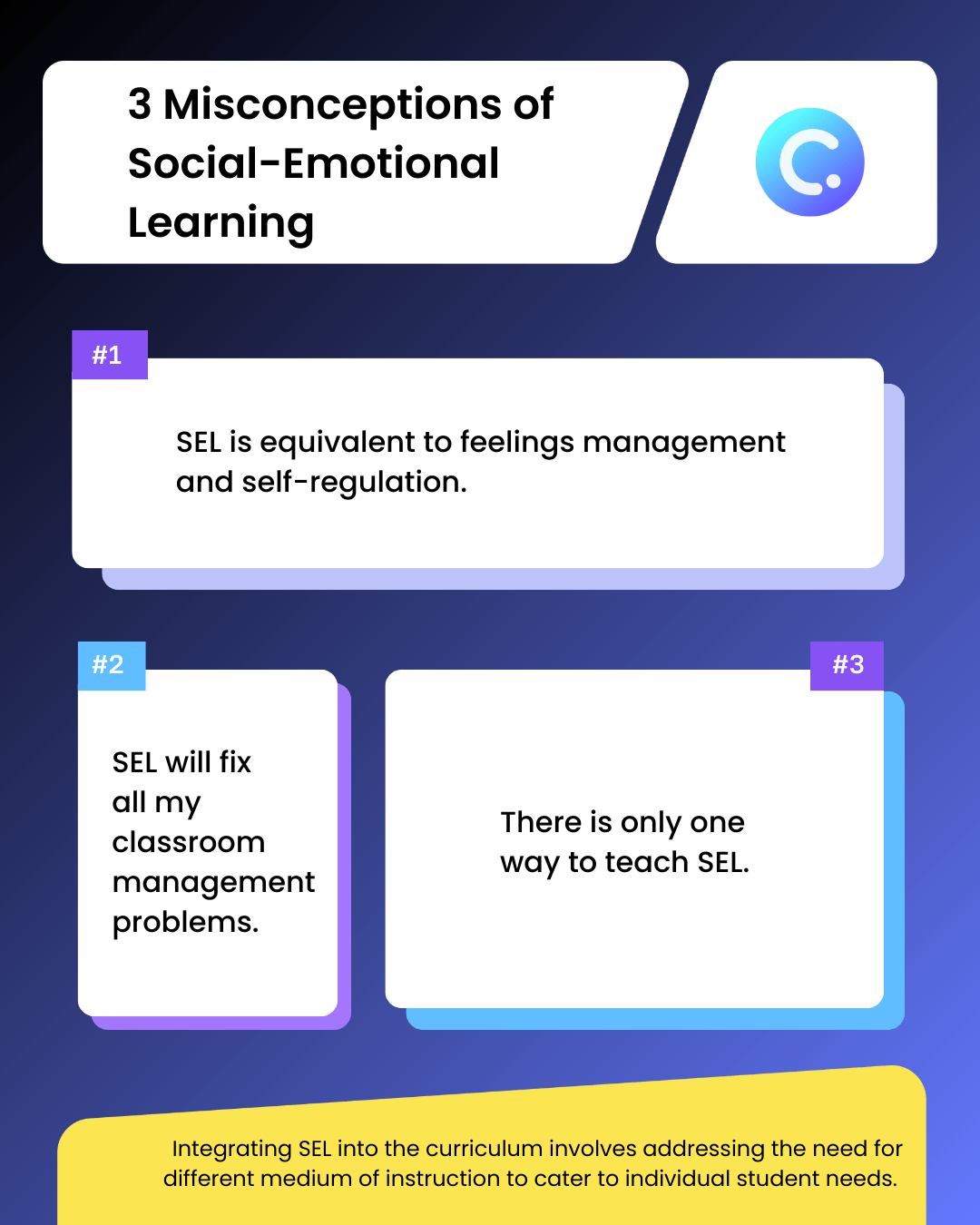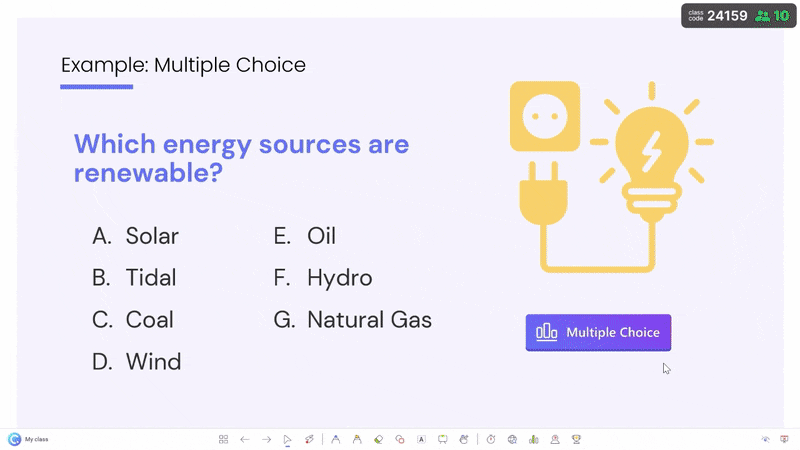Teaching’s a juggling act – between lessons and guiding young minds, there’s a vital part often overlooked: our students’ social-emotional well-being. The game-changer? The social-emotional learning curriculum.
Ever feel like you’re racing the clock, trying to cover the curriculum while something crucial slips away? The struggle is real, and too often, our students’ social-emotional growth takes a backseat.
But what if the social-emotional learning curriculum wasn’t an extra weight? What if it seamlessly became part of your daily teaching routine?
In this blog, we’ll share practical strategies to make it happen, lightening your load and bringing joy back into teaching. Ready to transform your classroom into a place where learning isn’t just about textbooks but about life? Let’s dive in.
Understanding Social-Emotional Learning Curriculum: A Concise Explanation
Before we delve into actionable strategies, let’s take a moment to grasp the very essence of social-emotional learning (SEL). Beyond the confines of textbooks, SEL equips students with life skills essential for personal growth and meaningful connections. Let’s take a look into the core competencies that underpin SEL, serving as a guide for you navigating the intricate landscape of students’ emotional and social development.
5 Core Competencies of Social-Emotional Learning

If you’re planning on building a social-emotional learning curriculum, it’s important to acknowledge that SEL revolves around key competencies that empower students to navigate life’s intricacies with resilience and empathy. A more in-depth exploration of these competencies provides a nuanced understanding crucial for the successful implementation of a social-emotion learning curriculum:
🌟 Self-awareness
Beyond recognizing emotions, self-awareness involves understanding the triggers, values, and beliefs that drive behavior. It sets the stage for emotional intelligence, allowing students to navigate a spectrum of feelings with insight.
🚀 Self-management
Equipping students with tools to regulate emotions, manage stress, and persevere through challenges fosters a sense of autonomy. The ability to set and work towards personal and academic goals becomes an invaluable life skill.
🌍 Social awareness
Encouraging empathy and an understanding of diverse perspectives forms the foundation of social awareness. It goes beyond recognizing emotions in oneself to appreciating the feelings and experiences of others, cultivating a sense of community.
One way to foster diversity in the classroom is by valuing cultural differences. More on our blog about building culturally responsive classroom management strategies here.
🤝 Relationship skills
Effective communication, active listening, and conflict resolution are vital components of relationship skills. Teaching these skills enables students to form and maintain healthy connections, preparing them for positive interactions in various aspects of life.
🧠 Responsible decision-making
This competency involves more than just making choices. It encompasses critical thinking, ethical considerations, and the ability to assess the impact of decisions on oneself and others. Instilling responsible decision-making sets the stage for a thoughtful and considerate approach to life’s challenges.
Impact of Social-Emotional Learning on Students’ Academic and Personal Development
Supercharging Academic Achievement
- Improved Academic Performance
Survey findings by Durlak et al. (2011) showcase a remarkable improvement in academic performance among students participating in Social-Emotional Learning (SEL) programs.
These students demonstrated a significant boost of 11 percentile points compared to their peers who were not part of SEL initiatives. This improvement goes beyond just test scores; it signifies a holistic enhancement in the students’ ability to grasp and apply academic concepts, showcasing the wide-reaching impact of SEL on scholastic achievement.
- Increased Graduation Rates
The study by Farrington et al. (2012) reveals that students exposed to SEL interventions are more likely to graduate high school successfully.
It delves into the long-term benefits of SEL by examining graduation rates.This finding is not just a statistic; it symbolizes a journey of personal growth and resilience nurtured through SEL, setting the stage for a positive trajectory in education and beyond.
- Enhanced Learning Environment
Taylor et al.'s (2017) research proves SEL fosters a cooperative and supportive classroom atmosphere.
Beyond individual achievements, students engaged in SEL programs end up contributing to creating a positive learning vibe, emphasizing the collective benefits that extend beyond individual success to create an inclusive and uplifting educational setting.
Pushing Personal Development to New Heights
- Enhanced Emotional Well-being
A study conducted by Sklad et al. (2012) reveals that SEL interventions equip students with tools to navigate emotions effectively, leading to a reduction in symptoms of depression and anxiety.
This study sheds light on the emotional well-being of students involved in SEL programs, underscoring the transformative power of SEL in enhancing not just academic performance but also the overall emotional health of students.
- Strengthened Interpersonal Skills
Jones et al.'s (2015) collaborative study indicates that SEL programs contribute to improved social behaviors, including better communication and conflict resolution.
The research examines the development of interpersonal skills among students engaged in SEL to which are fundamentally fostered not only for academic success but also for building meaningful relationships and navigating social complexities beyond the classroom.
- Empowerment and Resilience
Elias et al.'s (2015) study emphasizes a crucial aspect of SEL—its role in building resilience.
Beyond acquiring skills, SEL interventions empower students to bounce back from challenges, fostering a mindset of resilience that extends far beyond the academic sphere. This finding reinforces the notion that SEL is not just a short-term solution but a lifelong asset for navigating the ups and downs of life.
Addressing the Challenges of a Social-Emotional Learning Curriculum
In the quest to integrate a robust social-emotional learning curriculum, educators encounter challenges that are not only hurdles but opportunities for growth and transformation. Understanding these challenges and finding practical solutions is vital for the successful implementation of SEL curricula.
| Challenge | Solution |
| Limited Recognition of the Importance of a Dedicated Social-Emotional Learning Curriculum Educators and institutions may struggle to recognize the urgent need for a structured social-emotional learning curriculum, viewing it as an add-on rather than a fundamental component of education. | Advocacy and Professional Development Advocate for the integration of SEL into educational policies and provide ongoing professional development for educators. Illustrate how a dedicated social-emotional learning curriculum aligns with broader educational goals and contributes to academic success and student well-being. |
| Time Constraints and Lack of Resources Teachers often face time constraints and a shortage of resources when attempting to incorporate SEL into their already demanding curriculum. | Integrated Lesson Planning and Resource Allocation Encourage integrated lesson planning that combines traditional subjects with SEL elements. Advocate for the allocation of resources specifically for social-emotional learning curriculum development and implementation. |
| Overcoming Resistance to Change Resistance to change can impede the adoption of a new curriculum, particularly if there is a lack of understanding about the benefits of SEL. | Communication and Community Building Establish open communication channels to address concerns and misconceptions. Foster a sense of community among educators, allowing them to share success stories and strategies for overcoming resistance. |
| Assessing SEL Impact Measuring the impact of SEL on students’ academic and personal development can be challenging, hindering the ability to demonstrate its effectiveness. | Outcome-Focused Evaluation and Data Utilization Develop clear evaluation metrics that focus on observable outcomes, both academically and emotionally. Utilize data-driven insights to showcase the positive influence of SEL on student performance and well-being. |
| Limited Accessibility to SEL Training Teachers may face obstacles in accessing quality training programs to enhance their understanding and implementation of SEL strategies. | Online Professional Development Platforms and Collaboration Facilitate access to online SEL training modules, allowing educators to enhance their skills at their own pace. Encourage collaboration among teachers to share insights and experiences gained from training sessions. |
3 Most Common SEL Misconceptions

Below are 3 common mythes and misconceptions of SEL that further adds on to the challenges of implementing SEL in the classroom:
1. SEL is equivalent to feelings management and self-regulation.
SEL goes beyond managing feelings and self-regulation. It’s about understanding emotions, empathy, building healthy relationships, making responsible decisions, and having a sense of belonging in a community.
2. SEL will fix my classroom management problems.
While SEL can significantly improve classroom dynamics by fostering a positive environment and helping students develop social skills, it’s not a magical solution for all classroom management issues. It’s a part of the puzzle. Effective classroom management involves various strategies, including but not limited to, building a culturally responsive classroom, making learning fun and engaging, implementing edtech tools, trying out different teaching styles, and adapting different strategies according to education levels.
3. There is only one way to teach SEL.
Teaching SEL isn’t a one-size-fits-all approach. There are numerous methods and frameworks available, as we shall see below, and what works best can vary depending on the students, the learning environment, and cultural considerations.
In the classrooms of today, it is important to note the rise of technology apps and how these can promote accessibility and further improve student motivation. The good thing? Your favorite presentation app, PowerPoint, can be supercharged with a direct add-in that serves as your one-stop hub of everything you need to be a super teacher of the modern times. Say hello to ClassPoint - your partner in teaching. Turn slides into interactive quizzes, deliver dynamic presentations with handy slide show tools, increase recognition with a gamified reward system, and even get to use an AI quiz maker that does all the quiz prep, saving you hours from work!
10 Practical Strategies to Help you Build a Functional and Effective Social-Emotional Curriculum

Crafting a robust social-emotional learning curriculum is an intentional and systematic approach to nurturing students’ social and emotional skills throughout the academic year. Here, we delve into key strategies for developing a comprehensive social-emotional learning curriculum that creates a supportive learning environment.
1. Scope and Sequence Planning
Objective: Develop a roadmap for the entire school year, outlining the scope and sequence of SEL lessons.
Implementation: Begin by identifying the core competencies to address, such as self-awareness, self-management, social awareness, relationship skills, and responsible decision-making. Create a calendar that allocates specific timeframes for teaching each competency, ensuring a balanced and gradual progression. This foundational plan provides a clear overview of the SEL journey for both educators and students.
2. Skill Progression Mapping
Objective: Outline the progression of skills within each core competency.
Implementation: Break down each competency into skill components. For example, under “self-management,” skills may include emotional regulation, goal-setting, time management, and stress coping mechanisms. Map out how these skills will be introduced, reinforced, and advanced over time, considering the developmental stages of your students. This meticulous mapping ensures a scaffolded approach to skill development, catering to the diverse needs of the student body. Get a sense of what SEL skills are involved here.
Consider building this map together with your students live during a class session. Use ClassPoint's ready-to-use whiteboards or build a library of your own! Get to command with live inking to easily get the flow of discussion going. Consider rewarding skills progression with gamification!
3. Integrated SEL Lesson Plans
Objective: Infuse SEL into daily lesson plans to ensure consistent integration.
Implementation: Embedding SEL elements within existing subject matters enhances the relevance of these skills. During a literature unit, for instance, integrate discussions on characters’ emotions and decision-making, connecting these concepts to real-life scenarios. By seamlessly weaving SEL into the fabric of daily lessons, students perceive these skills as integral to their overall learning experience.
Access helpful resource and templates for building SEL lesson plans. Or DIY your own SEL lesson plans with the help of ChatGPT or ChatGPT alternatives.
4. Assessment Strategies for SEL

Objective: Develop methods to assess students’ progress in social and emotional skills.
Implementation: Design manual interactive quizzes or AI-powered assessments that align with the identified learning objectives. This might include reflective journals, observations, or project-based assessments that showcase students’ application of SEL skills. These assessments go beyond traditional measures, providing a nuanced understanding of how students navigate real-world scenarios and apply SEL principles in their lives.
Walk students to a path of increased motivation and tie up assessments with ClassPoint's gamification. With an engineered point system, you can award stars, get students to different levels with badges, and show a visual scoreboard.
5. Professional Development for Educators
Objective: Provide ongoing training for educators to effectively implement the SEL curriculum.
Implementation: Equipping educators with the necessary tools and understanding is crucial. Offer workshops, training sessions, and resources to help teachers comprehend the philosophy behind SEL, grasp effective teaching methods, and stay updated on the latest research and practices. A well-informed teaching staff is essential for the successful implementation of a comprehensive SEL curriculum.
Check out this page for a free SEL Educators Toolkit with learning modules.
6. Parent Engagement Programs
Objective: Involve parents in the SEL journey to create a collaborative support system.
Implementation: Parents play a pivotal role in reinforcing SEL principles beyond the classroom. Conduct workshops, seminars, or establish regular communication channels to keep parents informed about the SEL curriculum. Provide resources and activities for parents to engage with their children, creating a harmonious link between home and school in fostering social and emotional growth.
7. Crisis Response and Support Structures
Objective: Establish protocols for addressing challenging situations and providing support.
Implementation: Challenges are an inevitable part of any educational journey. Develop a classroom crisis response plan that includes steps for supporting students in difficult times. Implement peer support systems and involve school counselors in reinforcing SEL strategies during challenging periods. This proactive approach ensures a robust support structure that addresses the diverse emotional needs of students.
8. Continuous Evaluation and Adaptation

Objective: Regularly evaluate the effectiveness of the SEL curriculum and adapt as needed.
Implementation: The social-emotional learning curriculum is not static; it evolves based on feedback and outcomes. Collect feedback from educators, students, and parents to gauge the impact of the curriculum on social and emotional development. Use data to assess the effectiveness of different components and make adjustments based on insights gained from continuous evaluation. This iterative process ensures that the social-emotional learning curriculum remains responsive to the evolving needs of the student body.
Export data from the quizzes and assessments you have conducted with your students to Excel with CLassPoint's Quiz Mode.
9. Community Involvement and Partnerships
Objective: Extend SEL principles beyond the school walls by involving the community.
Implementation: Forge partnerships with local organizations, mental health professionals, or community leaders. Engage in collaborative initiatives that reinforce SEL values, creating a holistic support network for students. This interconnected approach ensures that SEL principles are reinforced in various aspects of students’ lives.
10. Student-Led Initiatives and Leadership
Objective: Empower students to take an active role in shaping the SEL culture within the school.
Implementation: Create opportunities for students to lead SEL initiatives. Establish student-led clubs or committees focused on promoting positive school culture. Encourage students to design and implement projects that align with SEL principles, fostering leadership skills and a sense of ownership in creating a supportive and emotionally intelligent school environment.
5 Best Practices and Free Resources for Implementing Social-Emotional Learning in the Classroom
- Teacher Modeling and Authenticity
- Practice What You Teach: Actively demonstrate the social and emotional skills you aim to instill in students. For example, openly express and manage your own emotions, showcasing healthy communication.
- Authenticity Matters: Be genuine in your interactions. When discussing emotions or conflict resolution, share personal anecdotes that highlight authenticity and vulnerability.
- Inclusive and Culturally Responsive Approaches
- Diversity Acknowledgment: Recognize and respect diverse backgrounds within the classroom. Integrate diverse perspectives into discussions and activities to create a richer understanding of emotions across cultures.
- Meaningful Engagement: Ensure SEL activities are relatable and meaningful for all students. Tailor examples and scenarios to encompass a broad range of cultural experiences.
Free Resource:
- Consistent Language, Vocabulary and Routines
- Clarity is Key: Establish a clear and consistent language for SEL to enhance understanding. Define key terms and phrases used in SEL discussions to create a common understanding among students.
- Shared Terminology and Routines: Foster a shared vocabulary and routines to facilitate communication and comprehension. Regularly reinforce and revisit key SEL terms to embed them in students’ daily discourse.
Free Resource:
- Student-Centered Approaches
- Empower Students: Give students an active role in their social and emotional development. Incorporate activities that allow them to identify personal strengths and areas for growth, or employ classroom management styles that encourage ownership or autonomy.
- Ownership and Agency: Foster a sense of ownership, allowing students to actively engage in the learning process. Encourage them to take the lead in certain SEL activities or discussions.
Free Resource:
- Emphasis on Emotional Regulation Techniques
- Practical Strategies: Prioritize teaching practical techniques for emotional regulation. Integrate activities that teach deep-breathing exercises, mindfulness, or other proven methods for emotional self-regulation.
- Resilience Building: Lay the foundation for emotional resilience and well-being. Discuss the concept of resilience and highlight examples where individuals bounce back from challenges through effective emotional regulation.
Free Resource:
Final Thoughts
Now that we’ve finally learned how social-emotional learning helps us guide students not just through lessons, but through the ups and downs of their feelings and relationships, it must be safe to say that building a curriculum centered on SEL is a secret weapon, helping us shape strong individuals who can handle whatever life throws at them. It’s not just part of the lesson plan; it’s a journey that changes students who they become.
When we see SEL in action, we see a future where being kind, understanding oneself, and making good choices become key to success. It’s the idea that everyone can be not just smart, but also kind and ready for anything. A bonus? You have the capability to make an environment where this ideology fosters, even beyond the classroom.
